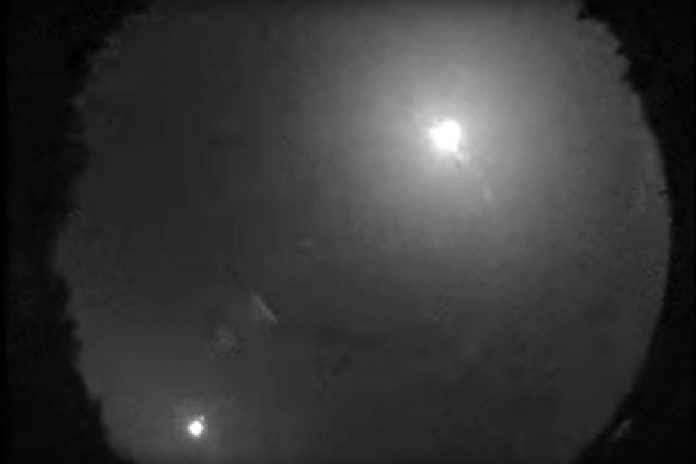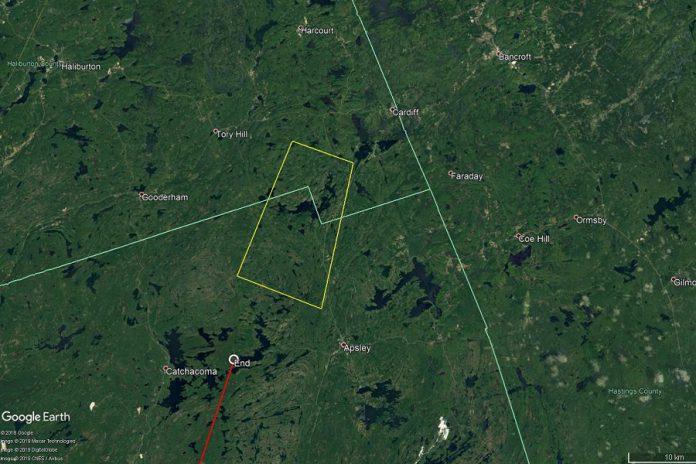
Researchers are seeking the public’s help in locating fragments of a fireball that may have dropped meteorites in the Bancroft area.
The fireball, which was as bright as the full moon, was observed by Western University in London at 2:44 a.m. on Wednesday morning (July 24).
Western’s Physics and Astronomy Department runs an all-sky camera network in collaboration with NASA’s Meteoroid Environment Office at the Marshall Space Flight Center in Alabama.
The network constantly monitors the sky for meteors.
VIDEO: Bright fireball event near Bancroft, Ont. may have dropped meteorites
Initial analysis of the video data by Steven Ehlert at the NASA Meteoroid Environment Office suggests the recent meteorite fragments are likely to have fallen to the ground near Bancroft
Astronomy professor Peter Brown confirmed that 10 all-sky cameras of Western’s Southern Ontario Meteor Network (SOMN) recorded a bright fireball over western Ontario on Wednesday morning. Cameras as far away as Montreal recorded the event.
“This fireball likely dropped a small number of meteorites in the Bancroft area, specifically near the small town of Cardiff,” Brown says.
Cardiff, in the municipality of Highlands East, is located 15 kilometres west of Bancroft and the same distance north of Silent Lake Provincial Park, located north of Apsley.
“We suspect meteorites made it to the ground because the fireball ended very low in the atmosphere just to the west of Bancroft and slowed down significantly,” Brown adds. “This is a good indicator that material survived.”
The fall zone of the fireball, where meteorites may be found, is southwest of Cardiff. As the fall zone contains two large lakes — Paudash Lake and Eels Lake — it’s possible fragments landed in water.

Preliminary results indicate the fireball first became visible just south of Oshawa over Lake Ontario at an altitude of 93 kilometres. It travelled over Clarington and passed just west of Peterborough before extinguishing just west of Bancroft.
The fireball rivalled the full moon in brightness and had a number of bright flares near the end of its flight. The meteoroid was roughly the size of a small beachball (around 30 centimetres in diameter) and likely dropped a small number of meteorite fragments ranging from tens to hundreds of grams on the ground.
Brown and his collaborators at Western and the Royal Ontario Museum are interested in connecting with people from the area of the potential fall who may have heard anything unusual or who may have found possible meteorites.
“Meteorites are of great interest to researchers as studying them helps us to understand the formation and evolution of the solar system,” Brown explains.
Meteorites can be recognized by their dark and often scalloped exterior. Usually they will be denser than a regular rock and will often be magnetic due to their metal content.
Meteorites are not dangerous. If recovered, it is best to place them in a clean plastic bag or wrap them in aluminum foil. They should also be handled as little as possible to help preserve their scientific value.
VIDEO: Peter Brown on Bancroft Fireball Event
In Canada, meteorites belong to the owner of the land upon which they are found. If people plan to search for meteorites on private propery, they should always obtain permission of the landowner first.
Brown notes that, due to the large fall zone and the likely size of the meteorites, a systematic ground search is likely to be fruitless. However, area residents should be on the lookout for any unusual rocks they find.
If you have found a meteorite that may be from this event, you can email Peter Brown at Western University at pbrown@uwo.ca and Kim Tait of the Royal Ontario Museum at ktait@rom.on.ca.


























